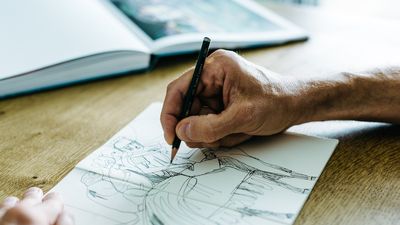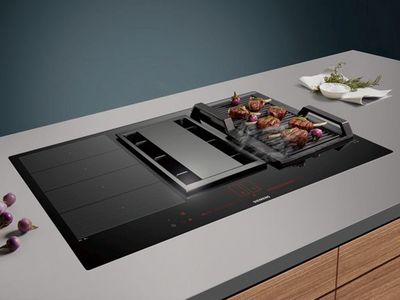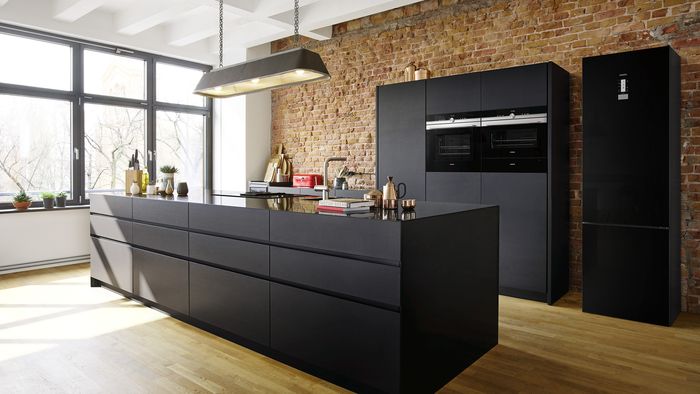Deeply relaxed, the 51-year-old Berlin-based artist sits at his three-meter-long living room table, looking beyond his open balcony across the centre of Berlin. Since Olaf moved from his old apartment to this new building two and a half years ago, he more and more finds himself working not in his studio but from home.
Olaf Hajek paints surreal images, shaped by mythology and African folklore that combine floral and physical motifs. As an illustrator, he produces commissioned works for The New York Times, The Wall Street Journal, Cicero, and the luxury fashion label Hermes.
In the morning, it takes Olaf a mere three minutes to walk from his apartment to his studio. Separating work and personal life would be straightforward and easy. Yet his home office provides him with the perfect space to organise his work, so that he can concentrate on his craft when he is in the studio.
Olaf, what's your typical workday like?
I'm the type of artist who likes to go to the studio early in the morning and not come back too late. My ritual is a daily breakfast of porridge, chia seeds and fresh fruit. Then I paint all day and when I get home in the early evening, I continue to work for a little while.
How does your work in the studio differ from work at home?
The actual painting takes place in the studio. But using the laptop or iPad there would make me restless. I separate the craft from research – finding ideas and writing e-mails. The studio is active chaos, while the apartment is my tidy, well-organised retreat.
So, at home you work on the research that informs your work in the studio?
I can think quite differently in my apartment compared to the studio. For me, coming home means winding down my day; I think quite differently here compared to when I’m in the studio. I stop focusing on my paintings and have new, inspiring thoughts.
Here I make sketches and research images. Most of my communication with galleries and customers is also done at home. Preparing exhibitions is about more than creating a world based on one's own imagination; it's also based on facts. My apartment helps me quite a bit with that.
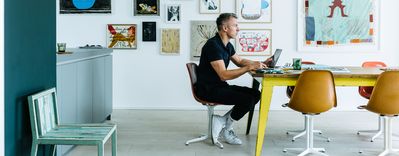
“For me, coming home means winding down for the day. I think quite differently here compared to when I'm in the studio.”
What object in your home best represents your idea of a home office?
The large table in the living room is important to me because it's like an island: A retreat, a working area and a meeting place for guests and friends. These are the kind of things that need to be in harmony with each other. I couldn't work in an apartment where my desk was hidden in a corner or behind a curtain.
Office workers who keep home offices often have difficulties with ‘work-life balance’. You don't seem to be affected by that. How do you manage this, and be productive from your home office?
This certainly has something to do with the practical atmosphere here: The new and the technical work together wonderfully. My previous, older apartment with its Bohemian style had oblique edges and holes in the walls – a place which itself seemed to be in need of work. The almost meditative finish of the furnishings here, bordered by strict edges, and the open floor plan give me the opportunity to work in peace – and live well at the same time. The art I've collected here also plays a role, of course.
How so?
It’s related to what I like, and what inspires me – the two belong together. I work a lot with different materials and textures, which is reflected in my art collection. It contributes to the atmosphere of the apartment, which is why I can enjoy working here.
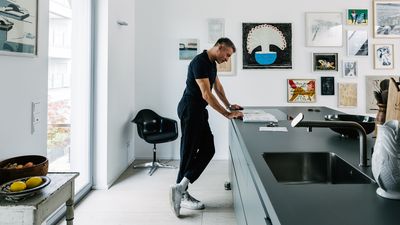
So, your home office reflects the mood you seek to create with your art? What about the rest of the design?
The apartment is flooded with light, and there's a vast array of windows and open architecture. These are things that I didn't realise could influence my work in a positive way. I only discovered this when I started living here.
How important is it for you to be able to access and use household objects while in your home office?
In my situation, for example, the proximity of the work table and kitchen is fairly ideal. I used to have a dining and study room cut off from the kitchen, now everything is quite compact.
What kind of media and technologies can help you with your daily work?
Two years ago, I got rid of around 1,500 books and magazines, as well as almost 5000 CDs. I used to buy printed magazines to get inspiration for new pictures, but today I look at them digitally and keep a lot of screenshots. I listen to a lot of music at work and it's now all digital thanks to streaming. But I still read printed books. I just can't do it any other way.
When do you finish your day?
There's no set time for me. My everyday life is permeated by my work. My work even reaches into the bedroom, which is why there's always a sketchbook next to my bed. Ideas that come during sleepless nights can be sketched right from my bed. Otherwise I can't get back to sleep.
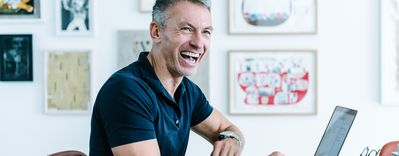
Thank you, Olaf, for sharing your intuitive ideas for a productive home office. Starting in March, his work can be seen in Johannesburg in the annex of the Whatiftheworld gallery in collaboration with the Southern Guild gallery.
Find out more

